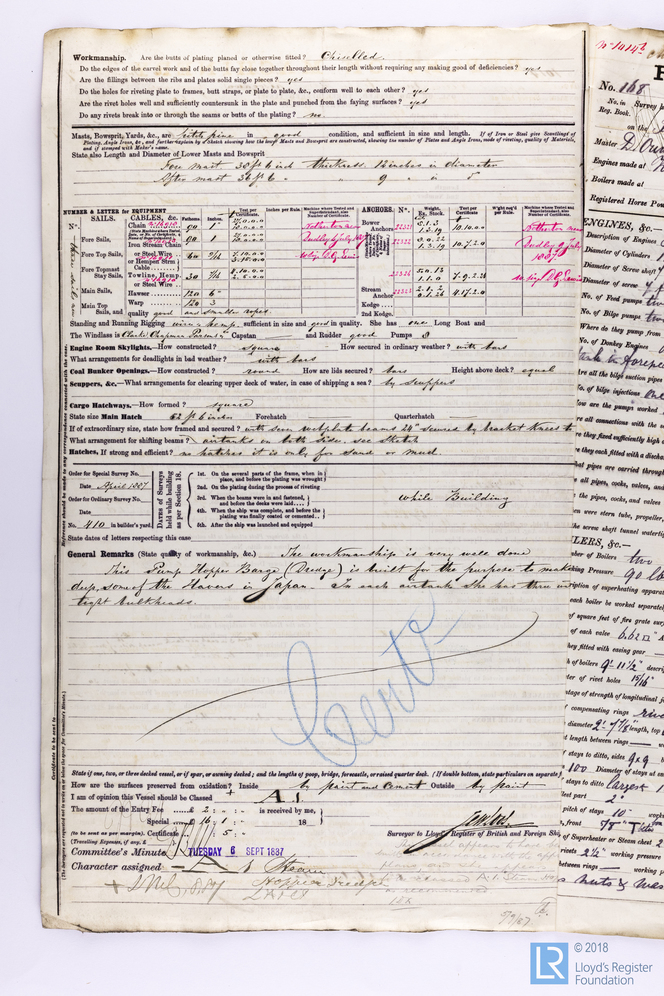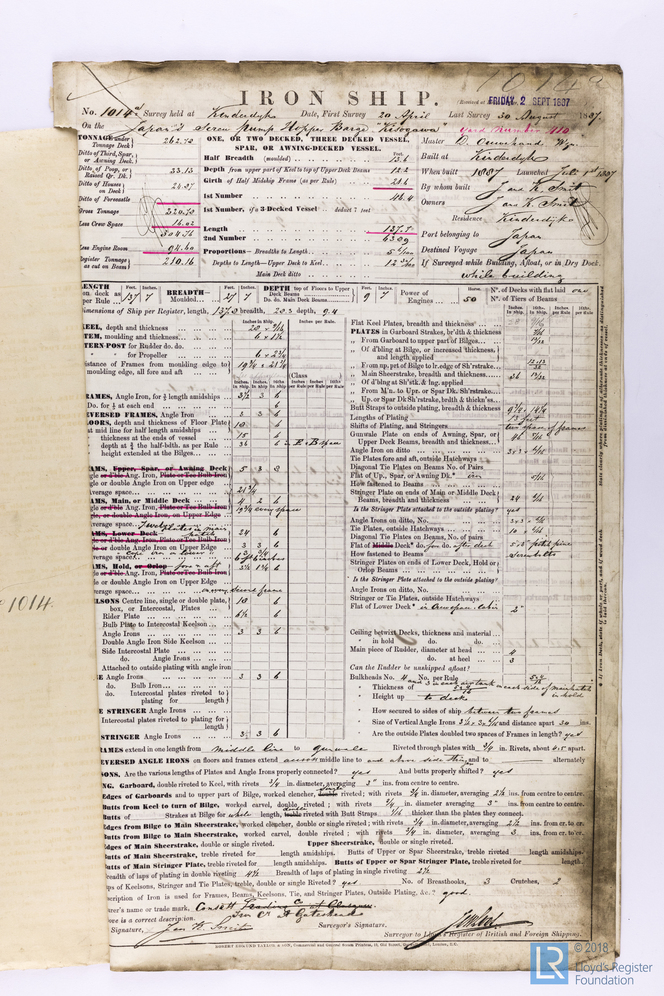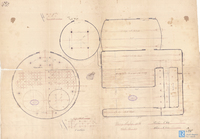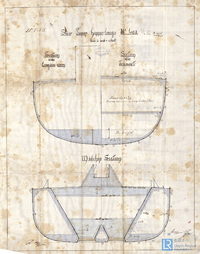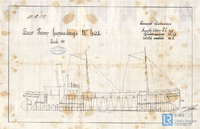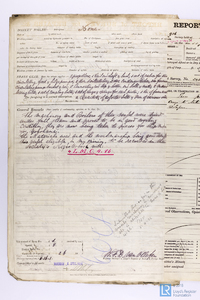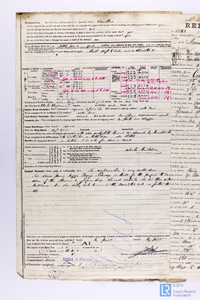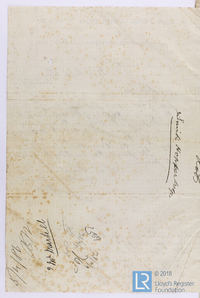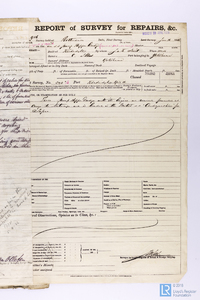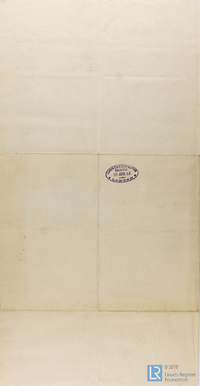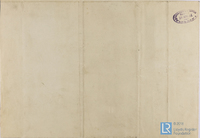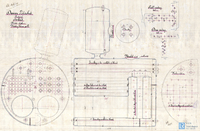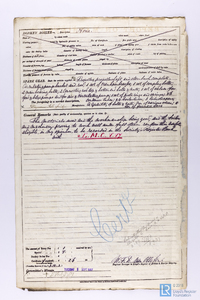- Related documents Related
- Full details Details
- Report document? Report?
Use the data export button to extract customised data sets from the Ship Plan and Survey Report Collection. Available in TSV and CSV formats.
Date recorded as the time of writing.
30/08/1887
The year in which a vessel’s construction is completed.
1887
The individual and/or organisation listed as having been responsible for constructing the vessel. This can/may be the same as the owner and/or manager.
J & K Smit
The port or place in which the vessel’s construction took place, at the time of writing.
Kinderdijk
Abbreviations of the names of ports with Lloyd’s Register survey offices.
Rot
Official administrative title (often printed) of a record used by Lloyd’s Register or external organisations.
Iron Ship
The listed port to which a given vessel belongs.
Japan
The date of first visit by a surveyor.
20/04/1887
An officially licensed mariner (post 1850) holding ultimate command and responsibility for a vessel.
D Ouwehand
Location where the document is written.
Kinderdijk
Location where a vessel’s survey was undertaken.
Kinderdijk
Date of the meeting of the Classing Committee.
06/09/1887
Broad categories and subdivisions of vessels related to their purpose or function.
Pump Hopper Barge
Is the steamer assisted by sail?
No
A ship’s total internal capacity of a ship measured in register tons from the top of the floors to the tonnage deck.
263
Confirmation as to whether the vessel was equipped with refrigeration machinery to aid in the transport of frozen or chilled cargo/goods.
No
Does the vessel possess an auxiliary power source?
No
Is electric lighting fitted to the vessel?
No
Used to indicate the capability of early reciprocating steam engines, based on dimensions rather than performance. It is not a true indication of actual engine power.
50
Length of a ship along the summer load line from the vessel’s stem to the sternpost.
137' 7"
Prescribed by flag/registration authorities, and usually excludes a small part of the stern. It is measured from the foreside of the stern at the extreme top to the afterside of the stern post.
137' 8"
Measurement from the underside of the upper deck on the centre line to the upper side of the bottom plating.
9' 4"
Name of ship as recorded on the record
Kisogawa
The process of transferring a vessel to water, but not necessarily her completion.
01/07/1887
Unique identifier for a given ship, it is assigned by a builder.
410
The country in which the vessel’s construction took place, at the time of writing.
The Netherlands
Unique internal numbers used for identifying, referring and retrieving a specific survey report.
1014
The country (flag) that a vessel is registered to, at the time of writing.
Japan
Records that constitute Lloyd’s Register’s first official encounters with a specific vessel, e.g. a survey report.
Y
The date of last visit by a surveyor.
30/08/1887
Name of the individual/entity/organisation responsible for authoring the record
Jan C W Loos
Name of surveyor.
Jan C W Loos
Classification symbol assigned to a vessel by Lloyd’s Register’s Classing Committee denoting the quality of construction and maintenance.
A1 steam; +LMC 8,87; Hopper dredger LARC
The name of the port/place of destination given.
Japan
Predominant material(s) utilised in a vessel’s construction.
Iron
System of measurement that replaced ‘Builder’s Old Measurement’, taking a vessel’s internal capacity as the standard. Vessels built between 1836 and 1854 were legally required to display both tonnages.
320
Tonnage derived by deducting from the gross register tonnage the capacity that in unavailable for cargo, e.g. machinery space, fuel, crew accommodation etc.
210
Is machinery fitted at the aft of the vessel?
No
Generally a smaller additional auxiliary boiler (often used while the vessel is at port).
No
Name of the Proving House responsible for the public testing and certification of a vessel’s anchors and/or chain cables.
No
Depth of vessel at ship’s side from the highest point of the upper deck to the lowest point of the keel.
12' 2"
Moulded dimensions breadth- Also referred to as moulded beam. The distance from the inside of the starboard side plating to the inside of the port side plating.
27' 7"
Also referred to as extreme breadth. The distance from the extreme starboard side to the extreme port side.
28' 3"
Physical extent of a record.
1
Report an issue with this document
Have you noticed missing or incorrect data or images for this document?
Please let us know and we will rectify the issue as soon as possible.

